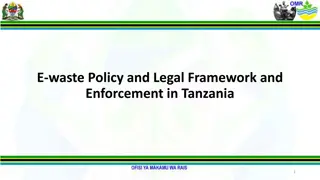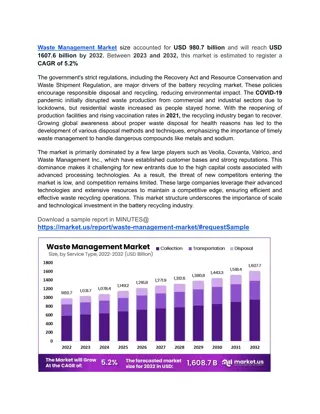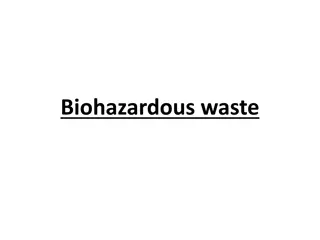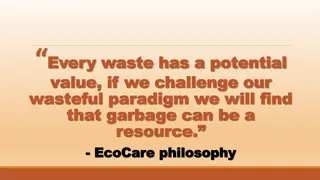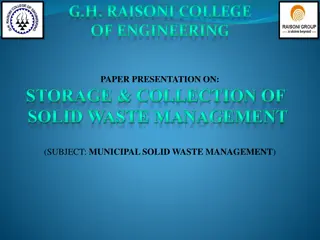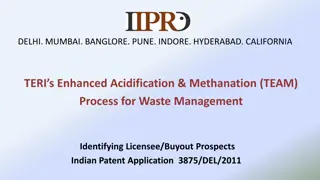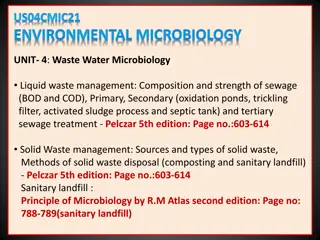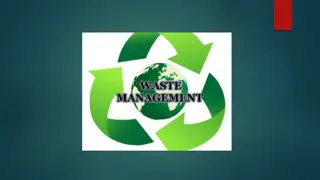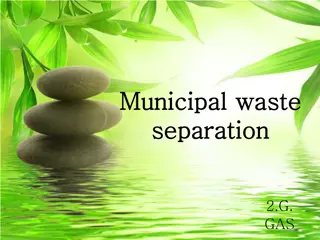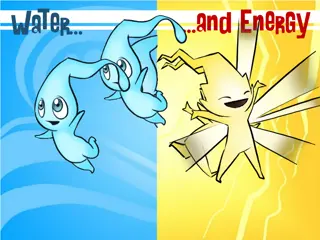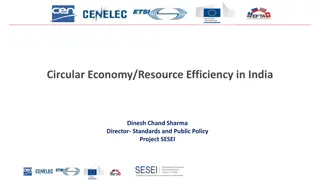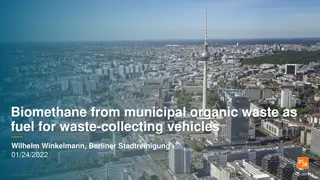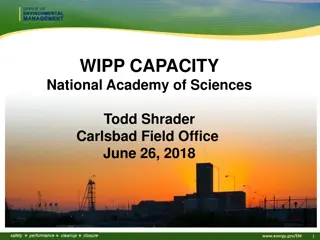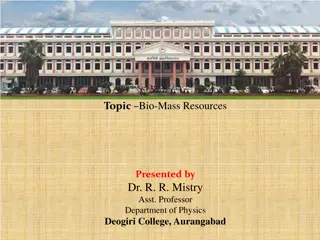Exploring Capacity Development in Waste to Energy Sector in India
The article discusses enabling factors for capacity development in waste to energy sector in India, highlighting challenges, developments, and regulatory aspects. It covers key perspectives from CERC orders, NGT directives, and the impact on waste management. The discussion emphasizes the importance of proper waste segregation, efficient incineration processes, and adherence to SWM rules for sustainable waste to energy solutions in the country.
Download Presentation

Please find below an Image/Link to download the presentation.
The content on the website is provided AS IS for your information and personal use only. It may not be sold, licensed, or shared on other websites without obtaining consent from the author. Download presentation by click this link. If you encounter any issues during the download, it is possible that the publisher has removed the file from their server.
E N D
Presentation Transcript
ENABLING FACTORS FOR CAPACTY DEVELOMENT IN WASTE TO ENERGY Presented By K Sreenivasa Rao ,Practicing WTE Engineer Mobile:9849204241
PRIMER The much touted alleged failure of Incineration plant set up at Timarpur has caused a road block for capacity development of Waste to Energy sector in India because sceptics, though the first two next generation RDF based Waste to Energy plants at Vijayawada (Shriram Energy Systems ltd) and Hyderabad (Selco International Ltd) have established that waste to energy is a feasible concept. With the commissioning of plant at Okhla, which underwent a traumatic period on socio- politico-administrative front and subsequently four more such plants in Delhi in last 10 years, has demonstrated the potential. The non permissible framework of tariff based bid system for waste to energy should be strictly implemented as it gives ULBs a chance to skip the essentials of MSW Management obligation cast upon the ULBs for segregation, recycling and sanitary landfilling of the residues in utter violation of SWM Rules 2016.
PERSPECTIVES Erstwhile order of CERC in 2015 The said order of CERC in 2015 , though a watershed order, has led to a state of confusion across the country in terms of grossly underestimated capital costs and needlessly brought distinction of a non- existing MSW Projects & RDF Projects. The said CERC Order is notable for following. MSW Projects were estimated to be set up with a capital cost of Rs 15 Cr /MW and out of which 40% is set off for Processing of MSW. Which means that MSW Projects are essentially Waste to Energy projects which use segregated MSW (RDF) at a total cost of Rs 15 Cr, bifurcated into Rs 9 cr /MW for RDF to Electricity and Rs 6 Cr for MSW to RDF totaling Rs 15 Cr/MW. Because fuel is processed within the estimated cost, there is no fuel cost for MSW projects. RDF projects are waste to energy projects estimated to be set up at a cost of Rs 9 Cr/MW for RDF to Electricity only and without any MSW to RDF process. It means that RDF is procured by the so called RDF based projects, thus a cost of Rs 1800/ton of RDF is fixed as fuel cost. The distinction as above is not necessary because SWM rules 2016 prescribe only segregated RDF having CV Of 1500 kcal/kg ought not go to SLF but to WTE or cement plants.
HONBLE NGT VIDE ITS ORDER 2016 DIRECTIONS Direction 6 of the NGT order 22-12-2016 ( page 83): Wherever a waste to energy plant is established for processing of the waste, it shall be ensured that there is a mandatory and proper segregation prior to incineration relatable to the quantum of waste. Direction 10 of the NGT order 22-12-2016 ( Page 84): In a waste to energy plant by direct incineration, absolute segregation shall be mandatory and be part of terms & conditions of contract.
CONFUSION CREATED BY CERC ORDER SERCs are most ill-equipped to deal with the subject matter of SWM and it is noteworthy that the same is outside the jurisdiction of SERCs as they are created by Electricity Act. Further SWM Rules 2019 Rule 9 has vested the power of determination of waste to energy tariff under s/62 with that of SERCs and Ministry of Power. Thus , the ULBs cannot undertake tariff based bidding process in violation of NTP 6.4 ( ii) read in conjunction with SWM Rules 2016 clause 9. CERC order in 2015 led to a belief by SERCs that MSW WTE means direct incineration without any processing and RDF WTE means combustion based on RDF. In fact, Tamil Nadu SERC has given order legally recognizing the mass burn (direct incineration) as a method.
TSERC ORDERS- UNDOING OF WTE A few critical orders by TSERC first in 2016 and then in 2020 need a mention. TSERC has not aligned with the available data by keeping the cost of RDF based WTE as Rs 9 Cr/MW in 2016 as well as in 2020 without any basis . The most misaligned part of TSERC Order is that the said Rs 9 Cr/MW for RDF based WTE projects in 2020 is inclusive of capital costs of RDF processing and thereby, it went a step ahead of CERC order of 2015 which prescribed MSW projects to be inclusive of RDF Processing. The order also has an element of regression in asking for a reimbursement of tipping fee, proposed to be Rs 3.54 /kwh out of Rs 7.84/kwh i.e 45% of tariff . It is quite fortunate that TSERC has not quantified the reimbursement of tipping fee though it proposed to be as much as Rs 3.54/kwh without rationale and logic, detrimental to the cause of SWM.
CAPITAL COST Capital costs for Waste to energy is not generally expressed in Rs/Cr , though all other forms of power plants are expressed so. The global practice is to express the cost as Rs INR per annual capacity of the waste incineration. For example, a WTE plant having two incinerators /boilers having throughput of 500 Tons of RDF per day, the total annual waste incineration capacity is 365000 Tons per annum. Hence, the capital cost of 500 Cr, it is global practice to express the capital cost as Rs 13700/ton of annual incineration capacity. The current cost of development in China is Rs 250 USD/Ton of waste incineration and direct incineration is allowed in China. Capital Costs for waste to energy plants range between Rs 12000 to Rs 14000/ton of annual waste incineration capacity . The practice of Cost per MW should be discouraged. Flue Gas Treatment: About 15 % of the capital cost goes towards the Flue gas treatment using milk of lime and carbon comprising of spray reactor and bag house.
AUXILIARY CONSUMPTION & STATION HEAT RATE Auxiliary Consumption: It is customary to express the aux consumption in terms of Kwh/ton of waste combusted. For example, a plant of 2X 500 TPD Incineration capacity will use about 1000 Tons per day. The aux consumption ranges between 50- 54 kwh/ton of combusted. The measurement as a % of generation is not followed as a norm in the WTE industry globally. Station Heat Rate: SHR and GCV are generally not considered as parameters for tariff determination for Waste to Energy. However, for notional purpose it may be considered as 3800 to 4200 Kcal/kwh for now.
CAPITAL REFURBISHMENT Grate bars, refractory, pressure parts are prone for corrosion, abrasion and slagging over period of time because of the alkaline nature of the waste and aggressive corrosion environment. The costs of refurbishment are considered as 20% of the Incinerator costs for every 5-year block starting after the first block of 5 years. Useful life to be considered as 25 years, after which the further operation requires large scale refurbishment. De-commissioning takes place in 35 years.
OPERATING TEMPERATURES SWM 2016 has increased the mandatory furnace temp to 950 Deg C with a 2 second residence time, making India as the perhaps only country in world with such condition of temperature to the detriment of the longevity of the incinerator. Globally, USA, Japan and Europe follow 850 Deg C min with a 2 sec residence time which used to be the condition in MSW (M&H) rules 2000. The amendment in 2016 to 950 Deg C is not scientific and has no technical basis. This has potential to cause a lot of corrosion and pose operational challenges to developers of WTE plants. International companies /developers are wary of this condition and a critical factor for not attracting investment into the sector. This aspect must be considered
PLF & AVAILABILITY There is a lot of gap in understanding PLF and Availability. Global practice is to provide an assured availability of running hours per annum. The average is 7500 hours and the best performers are 8000 hours per annum. However, the operating hours do not necessarily translate into PLF of a standard power plant. Because waste is heterogeneous and seasonally varies in spite of segregation, the electricity capacity is best achieved in summer, falls in monsoon. Thus, the average realizable value of electricity capacity is 85% of the installed capacity after stabilization, but safe to consider as 80% in a developing economy like India.
TARIFF Tariff for WTE power should be considered on a pragmatic basis and usual methods of cost plus approach does not strictly apply. The current state of development in India is that there are 12 operating plants in India since 2012. Means , one plant per year has been realized , while china has 4800 MW equivalent power generation over 400 units say 600 Tons per day as a unit capacity equal to 240000 Tons per day as compared to India s 12500 Tons per day currently and 170 MW. Tariff and tipping fee are the stumbling blocks for lack of development. The china policy of a national tariff of 0.65 RMB/kwh is worth emulating. A National tariff must be prescribed by Union Government, obviating the need for multiple SERCs to determine complex methods and policies ranging from capital costs to reimbursement of tipping fees and to delve into SWM aspects without jurisdiction. A tariff of Rs 7.50 /kwh is to be prescribed for WTE power to be mandatorily procured by DISCOMs in the concerned state. The state govt should take the burden of reimbursing the differential tariff to help lessen the burden on DISCOM as its obligation for promoting compliance and Swatch India pledge as may be agreed between DISCOM and State Govt , but to be monitored for compliance by SERCs in the ARRs for DISCOMs. Such National tariff is the call to be taken by Govt of India at this moment which will empower the ULBs to call for bids based on completion and attract investment.




